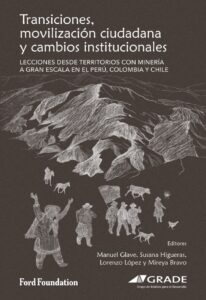Conflictos y consensos: los múltiples matices de la exclusión minera en el Perú
Transiciones, movilización ciudadana y cambios institucionales : lecciones desde territorios con minería a gran escala en el Perú, Colombia y Chile
| Year | : | 2024 |
|---|---|---|
| Author/s | : | Manuel Glave, Lorenzo López, Susana Higueras |
| Area/s | : | Natural resources, extractive industries and social conflict |
Glave, M., López Garnier, L. e Higueras, S. (2024). Conflictos y consensos: los múltiples matices de la exclusión minera en el Perú. En M. Glave, S. Higueras, L. López Garnier y M. Bravo (Eds.), Transiciones, movilización ciudadana y cambios institucionales : lecciones desde territorios con minería a gran escala en el Perú, Colombia y Chile (pp. 79-136). Lima: GRADE.
This chapter seeks to demonstrate that the delimitation of areas with mining restrictions promoted by the Peruvian state apparatus does not always enjoy the social legitimacy and institutional effectiveness necessary to guarantee the exclusion of mining in areas of high economic, cultural or socio-ecosystemic value. In contrast, exclusion zones established by social movements with high media visibility, or local or regional legitimacy, may be more effective in practice for these purposes. It also proposes that the generation of an institutional framework and the articulation of a regulatory system for the exclusion or restriction of mining activity in Peru must leave aside the current binary and minerocentric perspective. Instead, it should be nested within a broader and more participatory land-use planning policy, with a multi-sectoral and decentralized approach. Thus, this policy should be based on an initiative for social change from below, which means focusing on the active participation of local communities and populations as the driving force for socio-institutional transformation.







